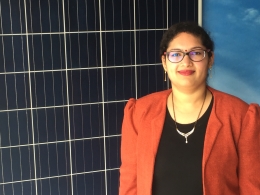10 July 2019
 With the boom in rooftop solar witnessed in recent years, a growing number of consumers are considering battery storage options in order to become less dependent on the main power grid.
With the boom in rooftop solar witnessed in recent years, a growing number of consumers are considering battery storage options in order to become less dependent on the main power grid.
Many consumers have been waiting for the market to cross the point at which a battery will save them enough money to ‘pay itself off’ within its warranty period, and researchers at the University of South Australia believe that point may have arrived for SA residents – under certain conditions.
Vanika Sharma is a PhD candidate at UniSA’s School of Engineering, and recently published a paper in the journal Renewable Energy that shows an optimally sized battery can now be economically beneficial in South Australia due to the combination of government subsidies, abundant sunlight, high electricity costs and relatively low feed-in tariffs.
“The crucial thing is to ensure you are getting the right size battery, and getting it at the right price,” Sharma says, “but if you are, then you can now have a battery that will pay itself off in the warranty period, which is the main concern for most people.”
While Sharma warns there are still many cases where batteries are not yet cost-effective, she has developed a calculation method to determine whether an optimally sized battery will pay itself off based on a range of factors, allowing consumers to adjust their initial investment against projected savings.
“The optimal battery size depends on various factors, such as load and PV generation patterns, battery cost and characteristics, retail price and feed-in-tariff of grid electricity,” Sharma says. “But this method can assess this all efficiently, and that allows people to make the right choice for their circumstances.
“Right now, in South Australia, the breakeven cost for installing a battery using this method is around $400 per kilowatt hour of battery capacity, and with the current subsidies of $500 per kilowatt hour, and retail prices on some batteries lower than $900 per kilowatt hour, you can have a cost-effective system.”
Sharma and her co-researchers, Dr Mohammed Haque and Professor Mahfuz Aziz, are also investigating whether storage alternatives, such as shared ‘community’ batteries, may present further benefits in respect to both cost and system efficiency.
“The focus of the research is to minimise the waste of PV, and so we’re also looking at whether it is more effective to have batteries on every home, or a central battery that could accommodate more PV, which would then also save distribution costs for providers,” Sharma says.
“The residential battery energy storage systems not only provide financial benefit to the customers but also address some of the operational issues associated with power generation, transmission and distribution,” Dr Haque says.
“The use of battery energy storage systems is likely to proliferate in the years to come. Future research and development should focus on how to leverage such storage to improve power system operation,” Prof Aziz adds.
………………………………………………………………………………………………………………………
Media: Dan Lander office (08) 8302 0578 | mobile: 0408 882 809 email: dan.lander@unisa.edu.au




